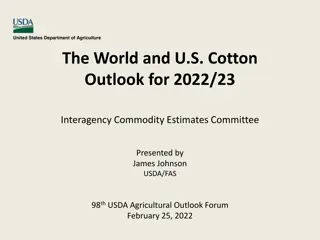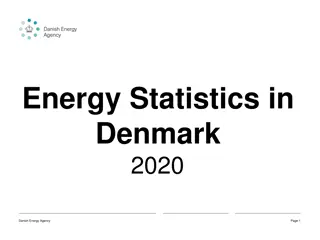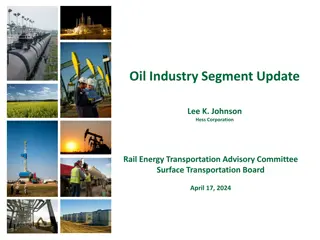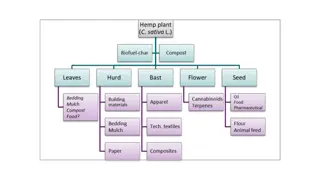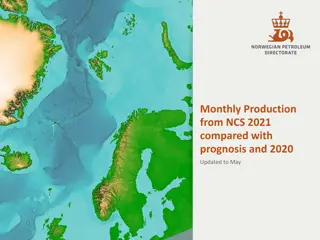Insights into Global Energy Production Trends and Environmental Impacts
Exploring historical world energy production data, Hubbert analysis for coal, and the global carbon cycle from the IPCC 5th Assessment Report. The discussion includes the longevity of fossil fuels, the rise of hydrocarbons, per-person energy production, and the shift towards universal electricity access. Evaluating logistic models for coal production against Representative Concentration Pathways (RCPs) for climate scenarios.
Download Presentation

Please find below an Image/Link to download the presentation.
The content on the website is provided AS IS for your information and personal use only. It may not be sold, licensed, or shared on other websites without obtaining consent from the author.If you encounter any issues during the download, it is possible that the publisher has removed the file from their server.
You are allowed to download the files provided on this website for personal or commercial use, subject to the condition that they are used lawfully. All files are the property of their respective owners.
The content on the website is provided AS IS for your information and personal use only. It may not be sold, licensed, or shared on other websites without obtaining consent from the author.
E N D
Presentation Transcript
Hubbert Analysis for Coal Dave Rutledge Engineering and Applied Science Caltech Food, Energy, and Water American Chemical Society, NOLA, March 2018
The Global Carbon Cycle from the IPCC 5th 2014 Assessment Report (WG1, Figure 6.1) 1. How long will our fossil fuels last? How much will we burn? 2. Note that the BP 2014 gas reserves are 107GtC
Hubbert Analysis for Coal Historical energy production and impacts Models for coal production CO2 emissions in climate scenarios (RCPs) Are the logistic models likely to be a better guide than the RCPs?
History of World Energy Production Gtoe = billions of metric tons of oil equivalent, 1 toe = 42GJ Wood and water from Arnulf Grubler, 2003, Technology and Global Change Coal, oil, gas, and alternatives from Brian Mitchell, International Historical Statistics, BP Statistical Review and the FAO (UN) on-line data base Hydrocarbons include natural gas, crude oil, and the natural gas liquids Hydrocarbons passed coal in 1956 87% of fossil-fuel production has occurred since then
World Per-Person Energy Production UN Population Division on-line data base Sources tend to rise until there is a shock, like World War I and the Iranian Revolution New alternatives: wind, sun, geothermal, biofuels, biogas
Moving Toward Universal Electricity Access Poverty $1.90/d 2011 PPP from http://iresearch.worldbank.org/PovcalNet/index.htm?0 Electricity access from various editions of the IEA World Energy Outlook With electricity access, many good things happen communities can provide clean water, people can preserve their food, hospitals can run operating rooms, people can deal with hot and cold
Coal Share of Electricity Generation in OECD and non-OECD Countries From various editions of the IEA World Energy Outlook
Models for Fossil Fuel Production Stanley Jevons The Coal Question, 1865
British Coal Production From the UK Department of Energy and Climate Change Mt = millions of metric tons The last underground mine closed in 2015
A Representative Cumulative Production Curve ?,for ultimate production, is the cumulative production in the long run, that is, total production, past and future ? needs to be estimated until the end of the production cycle we will use logistic models ? is the important number for CO2 concentrations because of the long residence times ?90is the time when the cumulative production reaches 0.9? One way to answer the question, how long will the coal last? with the warning that it is subject to shocks like the 1979 Iranian Revolution Gives a time frame for thinking about the transition to alternatives
Logistic Model for the UK Coal Production It appears that the total production will amount to 28Gt A logistic fit in 1871 or any time since then would have been close to this value
Linearized with the Logit Transform (UK) British coal records began in 1854 (from Jevons) Approach described in David Rutledge, 2011, Estimating long-term world coal production with logit and probit transforms, International Journal of Coal Geology the paper also includes information on individual regions Effectively vary U to give zero curvature the line parameters give t10, t90
Projections Compared with Reserves (UK) International surveys are World Energy Council Surveys and their predecessors Original reserves (??) current reserves + current cumulative production Produced only 18% of the 1871 Royal Commission original reserves Criteria chosen were too optimistic 1-ft coal seams, 4,000-ft depth Collapse in reserves in 1968 Strong political influence on reserves both at the beginning and at the end
German Hard Coal Production From the Statistik der Kohlenwirtschaft German hard coal (steinkohle) corresponds to the US bituminous and anthracite coal production is concentrated in the Ruhr Valley 2 mines left they close this year There is still a market for hard coal in Germany, but it is imported Heavily subsidized (200G so far) the deepest mines are 1000m
Projections Compared with Reserves (Germany) Note the log scale produced only 5% of the 1913 ?? Proved recoverable reserves (my emphasis) reported to the World Energy Council collapsed in 2004 from 23Gt to 183Mt with the most remarkable comment in the reserves literature Earlier assessments of German coal reserves (e.g. 1996 and 1999) contained large amounts of speculative resources which are no longer taken into account. The German resource agency (BGR) estimates are important because they have been used for the IPCC climate scenarios
Summary for Mature Coal Regions The median cumulative % of the early original reserves is 21% the original reserves were five times too high The range for ? has captured the correct values the median range is 20% The median production at ?90 (actual, not a projection) is 53% of the peak production
Western US Coal Production From the USGS and the Energy Information Administration Early production cycle peaked in 1918 centered on underground mines in Colorado, extremely limited by lack of railroad capacity to get customers New start after the 1970 Clean-Air Act Extension, which encouraged the use of low-sulfur coal, and the 1980 Staggers Rail Act, which deregulated the railroads now centered on surface mining in Wyoming The recent peak is 2008, the last year of the second Bush Administration before the fracking revolution and before the Obama Administration attacks on coal
Western US Coal Production ? is 38Gt 23% of ?? (162Gt) For comparison, the USGS made a detailed economic study in 2011 (Luppens et al.) for the Powder River Basin in Wyoming that currently accounts for 71% of Western coal production. They estimated the amount recoverable at twice the price then at 27Gt.
Chinese Coal Production From Elspeth Thomson and the BP Statistical Review 51% of world s consumption in 2016 Production may have peaked in 2013 now the world s largest importer
Projections Compared with Reserves (China) The current projection of 254Gt is consistent with the 2003 reserves from the Chinese National Bureau of Statistics Xie Heping, president of Sichuan University, stated in 2013 that shallow coal resources in the key coal areas [in China] have been depleted, leaving an average mining depth of approximately 600m
World Coal Production Six mature regions and ten active region The projection range from 1996 on is 9% ? is 784Gt, 64% of ?? t90 is 2066
Logit Transform for World Hydrocarbons Slowdown in the production pace from 1979 on causes a change in the linearized slope should consider t90 as a current trend that could be changed by a future shock The impact of the new shale gas and tight oil technology The EIA (2013) estimates 47% increased gas resources and 11% increased oil resources Will there be significant new production from the new technologies outside of North America?
Projections Compared with Reserves for Hydrocarbons In contrast to coal, the projections are higher than the original reserves The reserves have been rising 78% of the increase in oil reserves is OPEC
Combining the Fossil Fuels on a CO2 Basis Cumulative production GtC Ultimate production projection GtC Original reserves GtC t10 t90 Hydrocarbons 216 583 1977 2080 527 Coal 199 423 1947 2066 659 Fossil Fuels 415 1,006 1968 2075 1,186 ? is 1TtC, including a cumulative production of 415GtC ?? is 180GtC higher, not a significant difference ?90 is 2075 gives a business-as-usual time frame for the transition to alternatives
Reserves, Resources and Occurrences Shale gas technology Resources: economically interesting Occurrences: not economically interesting Reserves: proved, recoverable, economic Closed mines Proved means within a specified distance from an observation point Recoverable means adjusted for feasibility and losses in production Economic means that one could make money from production now Economically interesting means that there is a better than even chance that one would be able to make money in the future Resources may be hypothetical, that is undiscovered
Coal Resources in the IPCC 5th Assessment Report This report uses new scenarios called Representative Concentration Pathways (RCPs) The report is 4,852 pages long there are two mentions of coal resources From WGIII, Chapter 7, p. 525 For both reserves and resources, the quantity of hard (black) coal significantly outnumbers the quantity of lignite (brown coal), and despite resources being far greater than reserves, the possibility for resources to cross over to reserves is expected to be limited since coal reserves are likely to last around 100 years at current rates of production. (Rogner et al., 2012) coal reserves are likely to last around 100 yearsat current rates of production. is not consistent with the 5x increase in the RCP8.5 scenario resources to cross over to reserves historically coal reserves have turned into occurrences rather than the other way around The single reference to Rogner et al. is to a book edited by a lead author for a different chapter in the Assessment Report Table 7.2 on the same page lists coal resources as 14-21Tt (Rogner et al., 2012) [converted at 21GJ/t] the coal resources number can be traced to the German resources agency, the BGR
Coal Resources from the German Resources Agency (BGR) The coal resources for the earlier SRES scenarios came from the World Energy Council (3.4Tt in 1998) but the WEC reduced its resources to 180Gt in 2007 For the RCPs, the coal resources come from the BGR, which increased its resources after Sandro Schmidt took over from Thomas Thielemann in 2006 German hard coal 8Gt 84Gt (should be an occurrence, not a resource) UK 8Gt 191Gt (should be an occurrence, not a resource) US 806Gt 7,857Gt, the largest component is 3,500Gt for undiscovered coal on the North Slope of Alaska (16% of the world resources)
Comparisons With the RCPs CO2 TtC Google links Scenario RCP 2.6 RCP 4.5 RCP 6.0 RCP 8.5 Projection Reserves 0.3 1.5 2.4 5.6 1.0 1.2 61,500 101,000 65,800 149,000 From the RCP data base the CO2 totals include the past production I do not recommend RCP 2.6 there is no sign that carbon sequestration will take place on a significant scale I cannot recommend using RCP 6.0 or 8.5, because they are not consistent with the historical experience of coal mining for example, the production proportional to resources for RCP8.5 for the North Slope would be 1Tt, compared with the current cumulative US production, 74Gt
Per-Person Coal Consumption in RCP8.5 RCP8.5 digitized from Keywan Riahi et al. 2012 RCP8.5 A scenario of comparatively high greenhouse gas emissions Historical data is replot from an earlier slide Justin Ritchie of the University of British Columbia alerted me to this why would all this coal be burned?
Temperature in the IPCC 5th Assessment Report, WGII, Summary for Policy Makers (Figure SPM.4b) RCP2.6 and RCP8.5 are the only scenarios that appear in the SPM RCP2.6 has net negative future carbon-dioxide emissions massive carbon capture and sequestration is assumed
The Global Carbon Cycle from the IPCC 5th Assessment Report (WG1, Figure 6.1) 1. How long will our fossil fuels last? t90 = 2075 (RCP8.5 2227) How much will we burn? U = 1TtC (RCP8.5 6TtC) 2. Gas reserves are actually 108GtC (BP)
Summing Up Comparing the logistic projections with original reserves For coal, the projections have been more accurate than original reserves The projections are less sensitive to political meddling than reserves How do we get a sense of whether my projections are on the right track, compared to the RCP8.5 scenario? Hydrocarbon production has been twice coal production since 1970 there is no sign of this changing India is now the number 2 coal producer, passing the United States in 2016 however, I believe that India s reserves are simply not good enough to move the needle Chinese coal production has been declining since 2013 this is evidence that the 600m average mine depth is correctly indicating significant exhaustion











